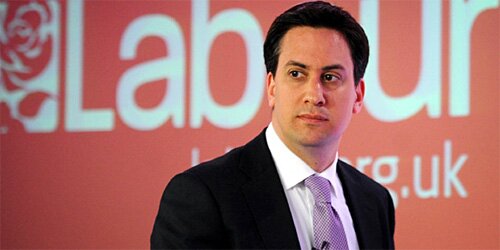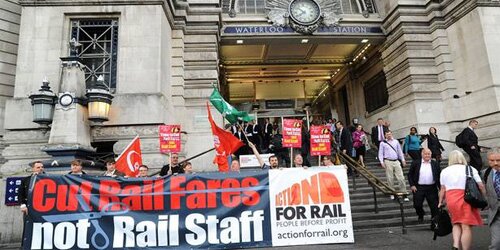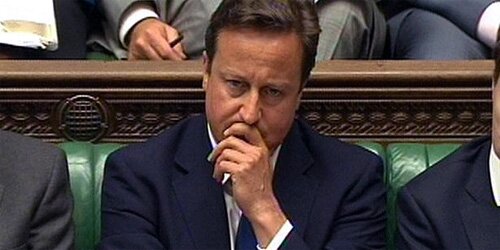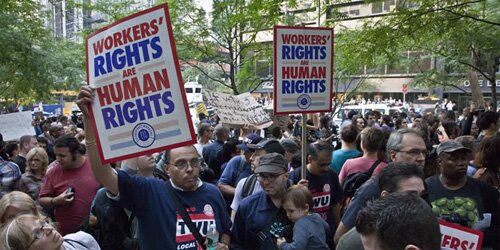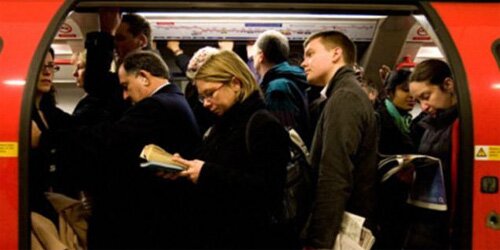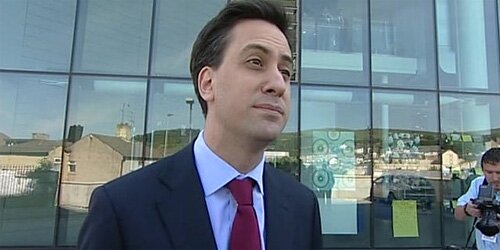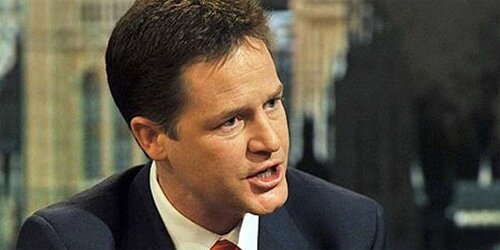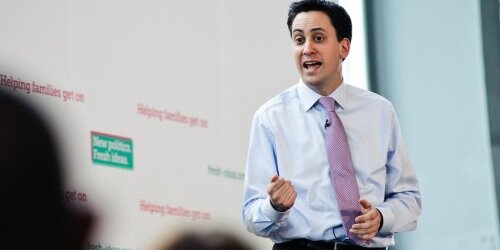Recent Articles
Why there’s more to Ed Miliband on the economy than many think
Ahead of the 2010 election much of the ‘economic debate’ was in reality a debate about the deficit and what combination of cuts and tax rises would be required to close it over what time period.
This whole spectacularly missed the point. The deficit was a symptom of wider economic problems not their cause – the real question should have been, why did we end with such a large deficit in the first place and what can be down to address that?
As the IMF has very clear shown, the UK deficit originated not from excessive public spending but from a collapse in tax revenues. And the reason the drop in taxation was so acute, was that it had become reliant on frothy asset markets and too few sectors.
In reality the UK faces three key problems – a problem of jobs and their quality, a problem of wages and a lack of investment.
The recent pick-up in growth cannot be seen as a confirmation that the government were right all along. They aimed for a rebalanced, steady and smooth recovery. Instead we had the best part of three years of economic stagnation followed by a recovery which is just as unbalanced as the growth we experienced pre-crash.
The crash was not caused by reckless driving but by problems with the car itself.
Our economy has serious problems – it is too dependent on consumer spending that is often debt funded, investment is too low, growth is too concentrated in too small an area and in too few sectors, the rewards from growth have increasingly been captured by those at the top, decision making is too short term and for too long the state has been left to pick up the pieces and paper over the cracks.
Labour at least seem to understand that we face bigger problems than simply boosting growth or reducing the deficit.
Whether one calls it ‘responsible capitalism’, ‘predistribution’, ‘economic reform’ or ‘rebalancing’, they are outlining an agenda that is about fundamentally shifting our national business model towards a higher waged, higher skilled, higher productivity path.
This is an ambitious agenda but perhaps a much harder to explain one. The tools used are more about building institutions than direct intervention. You don’t reverse 30 year trends in one parliament nor can you fundamentally alter how an economy works in one Budget.
Some people seem not to grasp this.
In February this year, Ed Miliband made one of the most thoughtful speeches on the economy I have heard from any major politician. At its core was an argument about changing the way our economy works but what grabbed people’s attention was some fiscal tinkering around the 10p tax rate.
For what it’s worth I think the economic reform agenda represents the surest, most sustainable way to generate steady growth, to protect and increase living standards and ultimately to deal with the deficit.
The big idea here is the direction of travel and the ambition not the individual policies. Each alone (whether extending training levies across sectors that want them, setting up a proper well capitalised SME and infrastructure bank, extending the living wage, changing corporate governance as outlined in the Cox Review, establishing regional banks, etc, etc) might not sound like much, but this a case of the total being more than the sum of its parts.
Too many people seem to be focussing on the trees and completely missing the woods.
—
A longer version of this post is here.
Our living standards crisis can only be solved by boosting wages
As I blogged last week, the squeeze on living standards has tightened since the end of the recession.
We are currently undergoing the longest squeeze in real wages since the 1870s, GDP per capita looks set to have a lost decade and the beginnings of the great wage squeeze can be found before the crash.
The latest inflation and earnings data demonstrate the extent of the squeeze clearly:

The chart above though is subject to two important caveats. Firstly the most recent earnings data have been distorted by income shifting ahead of the 50p rate tax cut (as I’ve written about today on Left Foot Forward) and secondly because the data above deals with average rather than median earnings. The picture for median earnings is considerably worse.
But the chart above also tells us something very important about what is causing our cost of living standards crisis.
Contrary to popular belief, it is not primary down to inflation. Now of course inflation is having an impact (big rises in rail fares, food bills and energy prices are hitting people’s standard of living) but in reality the primary driver of the squeeze on real incomes has been weak wage growth.
Over the period as a whole RPI averaged 3.0% – not very far from its current level. By contrast average weekly earnings growth averaged 3.2% – well below its current level (which is a reported 2.1% this month but stripping out distortions is almost certainly closer to 1.0%).
In other words the reason living standards are being squeezed is because of poor wage growth rather than high inflation.
Policy needs to go beyond fiscal stimulus and look at wider issues about how wages are set in the UK.
The TUC has recently published a pamphlet looking at this very topic. It identifies more than could be done with the minimum wage and the living wage and notes the crucial role of collective bargaining coverage in protecting living standards.
But it also notes that in the medium term much of the work of increasing wages will require a rebalanced economy that creates more higher skilled, higher waged jobs in the first place. Achieving this means a modern industrial policy, corporate governance reform and changes to our banking system.
To solve the crisis in living standards policy makers have to realise that the crucial driver is not inflation but wages. Boosting wages is the only sustainable way to close the living standards gap.
—
A longer version of this post is here.
Practical ways to raise worker wages in the UK

Today the TUC have published a new Touchstone Pamphlet from Howard Reed & Stewart Lansley. The whole thing can be downloaded here.
This is an important and timely publication. The TUC launched our “Britain Needs a Pay Rise” campaign three weeks ago and as I argued at the time, it is important to remember that Britain’s great wage squeeze predates the financial crisis.
Real wages are currently going through their longest squeeze since the 1870s and living standards have raced up the political agenda. Meanwhile last week’s GDP data suggested the UK’s current recovery is being propped up by a decline in the household savings ratio, rather than income growth.
Our current economic crisis is more than simple crisis of demand. Things started going wrong in the British economy before the crash – and one of those things was wage growth.
Today’s publication is about more than the need for better traditional macroeconomic policy – we do desperately need a fiscal stimulus, but a stimulus along isn’t enough. The aim of policy can’t simply be to return the economy to where it was in circa 2006.
I’ve argued that we need to think about economic reform in terms of changing our national business model. One important aspect of this is looking at how wages are set and how the gains from growth are distributed.
“How to Boost the Wage Share” looks at the practical impact of policies such as raising the national minimum wage, extending the living wage, fuller employment and (crucially) the role of extended collective bargaining through modern wages councils and new sector based institutions.
These policies would have immediate impact on wages, but the report also recognises that alone they are not enough.
Just as crucial in closing the wage gap is:
…a more active industrial strategy aimed at rebalancing the economy towards sectors that can support higher-waged employment.
We have heard a lot in recent months about the concept the ‘predistribution’, I think of this pamphlet as a guide to practical predistribution policies and strongly recommend taking a look at it.
How Osborne tried to mislead us today about boosting capital spending
George Osborne just made a great deal of fuss about his plans to increase capital spending from 2015/16. The immediate question is – how big is this boost?
The short answer is – there isn’t really one.
Osborne spoke repeatedly about investing £50bn a year and given current public sector net investment is around £25bn a year – these seems like an awful lot, a doubling of investment spend.
However, it appears Osborne was talking about increasing gross rather than net investment spending.
To clarify: the difference is that Depreciation is running at approximately 25bn a year. Osborne just started talking about a different measure, misleadingly.
Gross public sector net investment is around £47bn a year and was previously expected to be £50.4bn in 2015/16 according to the OBR (table 4.18).
In other words there doesn’t actually appear to be an increase in capital spending.
How very misleading.
This isn’t a real increase and it is not even scheduled to start for two years, the economy needs a boost now – not smoke and mirrors about the future.
Three major things I’ve learnt from recent Labour speeches
Following major speeches from Ed Balls and Ed Miliband a couple of weeks ago, the shape of Labour’s economic policy is becoming clearer. Another intervention from Ed Miliband this weekend provided more clarity.
So, what have we learned in the last month? I think there are three key takeaways.
The first is a new emphasis from Labour on the importance of capital spending – an emphasis which makes a great deal of economic sense.
This was evident in Ed Balls’ Reuters’ speech. Whether one uses the multiplier estimates of the OBR, the IMF or any other major forecaster the evidence is clear – capital spending has the highest multiplier. In other words, it is the most effective way to support growth.
One disadvantage of capital spending as a way to support the economy has always been the supposed lag in terms of a lack of ‘shovel ready’ projects. This is less of an issue at present with an obvious, clear and pressing need to build more affordable and social housing and also the convenient existence of the National Infrastructure Plan providing a list of potential projects.
When the challenge is to embed, sustain and accelerate a recovery rather than prevent the economy falling off a cliff, there is a clear case for capital spending over VAT cuts as a form of fiscal support.
Another obvious advantage of capital spending is that it not only boosts growth in the short run through its impact on demand but also can provide longer term benefits. A VAT cut boosts growth, but capital spending also provides some form of longer term asset – be it more houses, better infrastructure or more roads.
The second part of Labour’s emerging policy position is a nod towards new fiscal rules.
This is often presented as Labour accepting Coalition spending plans, but I’m not at all sure this is the case. It is worth remembering that the forthcoming CSR is only taking spending to 2015/16 and, under the current fiscal framework, even more savage cuts are required in the following years.
In many ways the current framework is the worst of all worlds – too flexible to actually ‘deal with the debt’ but too short term to allow any support for growth. It is perfectly possible to design a better framework – one that acts over a longer period, is responsive to the economy and which recognises the key role of growth in getting the debt/GDP ratio down in a sustainable way.
Such a framework might start by targeting lower debt/GDP by, say 2025, as suggested by Nick Pearce (£).
As I’ve often argued – a short term focus on debt risks the UK underinvesting in its future. You can’t cut your way to victory in the ‘global race’ the Prime Minister is so keen to remind us of.
The final element in Labour’s emerging position is perhaps the most important. What is often called ‘responsible capitalism’ but what cools be thought of as ‘supply side reform’. Something I’ve written about at some length over the past year.
It is important to remember that as well as a pressing problem of weak demand, the UK faces deeper problems. Things were starting to go wrong well before 2008 – median wages stagnated, consumer debt rose, the economy was unbalanced. Fixing these wider problems requires more than a new fiscal policy. It needs wider changes to our national business model.
Questions of course remain – what role does taxation play on Labour’s plans? What will their fiscal rules look like? How do they see the role of monetary policy? But the outline of the agenda is now pretty clear.
—
A longer version of this blog post is at Touchstone blog.
Britain’s crisis: real wages have been falling for 40 months
As the TUC noted yesterday real wages in the UK have been falling for 40 months.
The last time average wages grew by more than inflation came all the way back in November 2009.
The chart below provides some context to this, it uses data from the Bank of England’s Three Centuries of Data spreadsheet to show inflation (in this case CPI), wage growth and real wage growth from 1855 to 2009.

We are now in our fourth year of falling real wages, something which hasn’t happened since the ’70s.
The 1870s that is.
The last real wage squeeze of this duration seems to have been 1875-1878.
This is why the TUC’s latest campaign is entitled, Britain Needs a Pay Rise.
Britain’s great squeeze on wages is a real and major problem
Yesterday the TUC launched its Britain needs a pay rise campaign. We published research showing that, in real terms, Britain’s total pay packet has fallen by over £50bn since the end of 2007. The Guardian provided a good write up of the key findings.
There is no doubt that the last few years have been tough for most people. Real wages have been falling since early 2010 and nominal pay growth is now at its weakest level since at least 2001. Although the pain is not being equally shared, with data out yesterday showing that the pay packet of the FTSE Chief Executives rose by an average of 10% in 2012 (£).
The response of some commentators when faced with these facts is to assume that it is nothing new. On twitter the Economist’s Daniel Knowles asked if this was not just evidence that the economy was not growing? Obviously this a fair point – the economy has been doing badly and this has impacted on the earnings of most people. Two weeks ago the IoS’s John Rentoul expressed a similar point of view.
He sums up by saying: “the cost of living crisis” is just a way of saying “the recession.”
I’m afraid that is not true. I wish it were so, for if it were simply a case that the recession had hit people’s incomes then the solution would be relatively straight forward – boost demand, restore growth and enjoy the fruits of that growth.
By using a mean measure of expenditure per head somewhat misses the point. First the debate is really around incomes not expenditure – expenditure running ahead of incomes and the resulting build up of personal debt was a major factor contributing to the crash. (The key IMF paper on this is well worth a read, and one of its authors is speaking at the TUC next month). But more crucially Rentoul has used a mean when we should be using a median. Imagine if we had an economy with only ten people who all earned £25,000 a year and one year one of them saw their income increase to £250,000. Mean income per head would increase to £47,500 – a fairly staggering increase – but 9 out of 10 people would see no rise in their income level. Using a mean in this example would give a highly misleading picture.
The Resolution Foundation’s Commission on Living Standards looked at the data in detail. It found that from 2003 to 2008 median wages flat-lined, average disposable incomes fell in every English region outside London and spikes in the prices of essential goods squeezed family budgets.
It also warned that:
Millions of households are heading for a long period of stagnant living standards unless bold steps are taken to ensure that growth over the next decade is broadly shared. Even with a return to steady growth, it’s now entirely possible living standards for a large swath of low and middle households will be no higher by 2020 than they were in 2000.
In other words, something was going wrong before the crash. The striking falls in real wages over the past three years, follow on from a period in which for many people their pay packet had simply stopped growing.
This was driven by two major factors – an increasing proportion of the wage growth that there was being taken by those at the top and a fall in the overall share of the economy being paid out in wages over a three decade period. On this second point I’d highly recommend a recent TUC Touchstone publication.
By coincidence, Gavyn Davies has been writing about the same issues over at the FT’s own blog today.
He presents the following chart:

If we accept that what is happening to wages right now is not simply the result of the recent recession (and the evidence certainly suggests this) then the current debate about around macroeconomic policy has to move beyond how we simply return to growth and into questions about how we ensure that any growth we do get actually benefits most people.
Some of the answers are the subject of a forthcoming Touchstone pamphlet but they involve not just action to push up wages but also policies aimed at making sure our economy generates better paying jobs in the first place.
This policy debate takes us away from the traditional levers of macro policy and into a broader discussion about reforming our national business model.
—
A longer version of this blogpost is here.
The UK needs to worry about ‘depression deniers’ not ‘deficit deniers’
I’ve written before that I find the current political debate ahead of the spending review somewhat confusing. The Government, and many of their supporters in the media, now appear to think that the way to gain “economic credibility” is to commit to a fiscal plan that has failed to achieve growth, deal with the deficit or even retain the UK’s AAA rating.
The argument can be summarised as: “our plan has failed to achieve any of its goals and opposition parties will only be seen as credible if they agree to stick with it.”
I’ve argued before that the real debate ahead of the coming CSR should not be whether political parties sign up to it but instead what the UK’s fiscal framework should look like.
A more appropriate framework for the UK would focus on reducing debt/GDP over a much longer timetable.
The more I think about it though, the more I think an even bigger point is being missed in the current debate around the politics of the CSR.
On most forecasts the economy is still likely to be depressed in 2015/16 and indeed 2016/17.
The crucial number to examine here is the output gap – and in particular the OBR’s own assessment of it.
Simply put, the output gap is a measure of how much spare capacity there is in the economy. If the output gap is negative then the economy is operating below capacity and there is a strong case for expanding demand to make good the difference While if the output gap is positive then the economy is operating above trend and may be overheating with consequences for inflation.
Back at in June 2010 the OBR forecast that by 2015 the output gap would be -0.9% of GDP, i.e. the economy would be operating a below potential but not by a huge amount.
The current OBR forecast is for an output gap to be -3.4% in 2015 and still at -2.9% in 2016. In other words, come April 2016 (the time when any new government can actually make spending decisions in a meaningful manner) the economy is still expected to have an output gap of almost three per cent . The OBR’s own forecasts imply that there is room for a fiscal expansion of almost three per cent of GDP in 2016/17.
Recent work from NIESR, funded by the TUC, found that in ‘crisis times’ (when output is depressed – i.e. a -2.9% output gap implies ‘crisis times’) then a capital spending intensive stimulus of 2% of GDP will boost growth, lower unemployment and lead to a lower debt/GDP ratio in the medium term.
Much of the current politics around the CSR feels “very 2010”.
The assumption in much of the political (if not the economic) coverage of the CSR seems that by 2015 macroeconomics will not really matter. The economy will broadly have recovered and the task of the Treasury will the essentially distributional job of managing cuts in public spending and tax rises to close the deficit, rather than actively managing demand and boosting growth. This is looking like an increasing optimistic view.
The economy in 2015 and 2016 is likely to remain, by any reasonable standard, depressed. The case for a new fiscal framework, which gives governments the room to borrow to boost growth in the short term, will remain strong.
To put this all really simply, we shouldn’t be so concerned about the ‘deficit deniers’, it’s the ‘depression deniers’ we need to worry about.
—
A longer version of this post is at Touchstone blog.
Is the British economy actually ‘healing’? Let’s look at the evidence
The Chancellor has long been keen to tell us that “the economy is healing” and, according to the latest Bank of England forecasts, he might finally have some justification in saying this. At his press conference last week the Sir Mervyn King was able to revise up growth forecasts for the first time since the financial crisis hit.
The Bank now expects growth in 2013 to come in around the 1.2% mark, an upward revision from the 1.0% it expected in February and twice as high as the OBR’s own estimate of 0.6%.
Presented with this information, one response is to hail ‘Good news Britain’ and point out that the Bank now expects a recovery twice as fast as the OBR.
Another, and I would argue more correct response, is to note that whilst growth of 1.2% is obviously preferable to growth of 0.6% it is nothing to shout about.
Indeed the OBR expected growth of 1.2% in 2013 as recently as last December. The initial OBR forecast for 2013, on which the Government’s fiscal plans were based, was for growth of 2.9%. No one now thinks 2.9% growth in 2013 is remotely plausible.
The economy might be healing in as much as it is showing some tentative signs of growth but whether compared to the original forecasts, to international experience or to the UK’s own history this is an appallingly weak recovery.
As I noted a few weeks ago, on the IMF’s forecasts (as good as any) the UK is set to experience a lost decade of GDP per capita growth. This is not what a ‘healing economy’ looks like.

Real wages have fallen by a huge 8.5% over the past three years.
Even leaving aside inflation, nominal earnings have been falling since last summer. And, as James Plunkett notes on twitter, the level of people in employment has dropped since the end of 2012.
It is an odd recovery indeed that is accompanied by falling employment and falling incomes and it is even odder that anyone can look at the UK data and see much to celebrate.
So, if the labour market is stagnant and real incomes are squeezed, where is this modest recovery coming from?
One answer can be found in the housing market where prices are once again rising.
The early indications are that the Chancellor’s interventions in the housing market are starting to bear fruit, prices are heading north and activity is picking up.
The real worry now is that the Government’s housing interventions (that push up prices not building) will mean we get an increase in growth funded by yet more household debt.
Some will no doubt argue that a few years of faster growth are a better out turn than stagnation. Whilst this is true we shouldn’t kid ourselves that an asset price, consumer debt led recovery is a good, or sustainable, outcome.
—
A longer version of this post is here.
Regardless of what Osborne says, the UK will go through a ‘lost decade’
The past two weeks have provided some good and some bad news on the UK economy. On the one hand GDP data for Q1 2013 was better than expected.
Whilst on the other GDP per capita figures suggested that the hole we are currently in is much bigger than previously thought.
GDP per capita measures economic output per person. In many ways this is the most sensible way to measure growth over the medium term and the best way to compare growth across nations.
As the IMF mission arrives in the UK to assess our economic performance, the TUC have used IMF data to look at GDP per capita over the advanced economies.
As can be seen in the table below the UK’s performance is abysmal.

Over the decade 2008 to 2017 the UK will experience, according to the most recent IMF forecasts, GDP per capita growth of 0.0%.
In real terms GDP per capita was £23,777.32p in 2008; by 2017 it will have reached just £23,768.25p. In terms of growth per head the UK is set to have its own ‘lost decade’.
The data really tells us three things.
First that the UK experienced an especially severe recession in 2008/09, second that the recovery has been historically weak and drawn out and thirdly that in terms of the ‘global race’ that the government is so keen to talk about, we are doing especially badly. Amongst the G7 only Italy is expected to underperform the UK.
If there is a global race, then we are certainly losing.
The Resolution Foundation has calculated that median real wages are set to be well below 2008 levels in 2017. In fact real median wages are set to be below 1999 levels as late as 2017.
We face a lost decade of growth and two lost decades of living standards, we are losing the global race, deficit reduction is widely off track and yet the Chancellor still refuses to change course.
—
A longer version is at Touchstone blog
NEWS ARTICLES ARCHIVE



